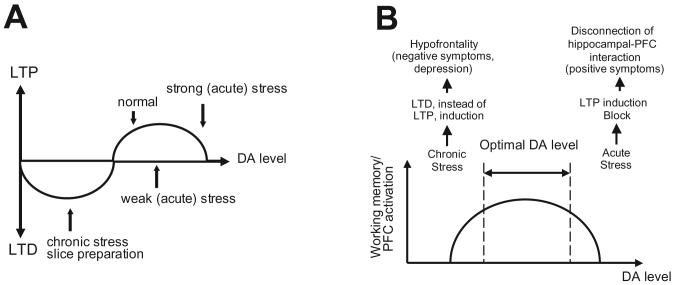Figure 1.
Based on findings from animal studies, several models can be derived to account for some of the observations made regarding possible underlying biological mechanisms of psychiatric disorders such as schizophrenia. (A) In the normal condition at a moderate level of DA tone, long-term potentiation (LTP) is induced with high frequency activation of PFC afferent fibers such as those arising from the hippocampus and participating in memory-guided behavior. A brief exposure to stress would increase DA release in the PFC, and thereby facilitate DA-dependent induction of LTP, whereas if the stress exposure is severe, an excess in DA release could occur, leading to impairment of LTP (e.g. via stimulation of extrasynaptic DA receptors). In contrast, in the case of chronic stress, where a significant decrease in DA tone is produced, PFC networks would preferentially shown LTD. Such a condition is likely to be present in the in vitro slice preparation, in which the DA tone would be expected to be low. (B) Acute stress induces excessive DA release, which in turn over-stimulates D1 receptors in the PFC. As a result, information processing mediated by hippocampal-PFC interactions, which depends on LTP, would be disrupted. In contrast, attenuated DA tone, which could be produced by chronic stress exposure, would also interfere with proper information processing in the hippocampal-PFC pathway due to the abnormal induction of LTD. Indeed, this LTD may contribute to suppression of PFC activity (i.e. hypofrontality).

